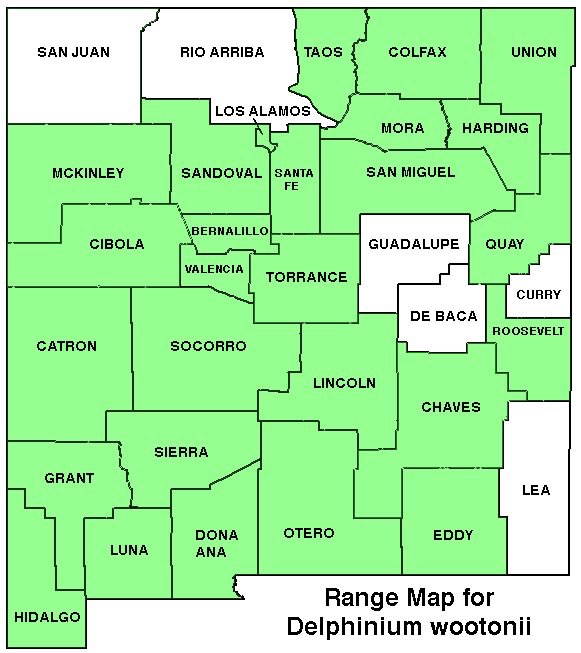WILDFLOWERS OF NEW MEXICO

Stems 12–20-inches tall from a dense basal rosette of deeply lobed leaves are topped with spike-like clusters of 1-inch, irregular, pale blue to lavender or white flowers. Note the nearly leafless stem, and the flowers with long spurs and white lower petals covered with long, curly white hairs.
FLOWER: May–June. Spike-like clusters (racemes) on upper stem; flowers irregular, spurred, light-blue to lavender or whitish; 5 sepals showy, petal-like, white to lavender; side sepals fold backwards, the upper sepal forms ascending spur; 4 small, white and blue petals. The upper sepal encloses 2 petals to form a 1/2–3/4 inch long (15–20 mm), upward-pointing, curved spur that contains the nectary to attract pollinators; the lower 2 petals are whitish-lavender, deeply notched and densely covered with white hairs and arch over the stamens. The fruit is in a tight, erect (not spreading) cluster.
LEAVES: Basal leaves present at blooming; stem leaves alternate, scattered. Basal blades fan-shaped to oval, 1 1/4–2-inches wide (3–5 cm), and deeply lobed; petioles to 3-inches long (8 cm); surfaces covered with short, curly hairs (use lens). Stem leaves smaller with narrow lobes.
HABITAT: Sandy, gravelly soils, roadsides, plains, foothills, disturbed areas; desert grasslands and scrub, pinyon-juniper, oak woodlands.
ELEVATION: 2,500–6,200 feet.
RANGE: AZ, CO, NM, TX.
SIMILAR SPECIES: The desert/grasslands habitats, short stem, and showy, pale-blue to white flowers help distinguish this species in NM. New Mexico Larkspur, D. novomexicanum, in southern NM mountains, reaches 3+ feet tall and has smaller, not very showy flowers.
NM COUNTIES: Nearly statewide in low- to mid-elevation, dry habitats: Bernalillo, Catron, Chaves, Cibola, Colfax, Dona Ana, Eddy, Grant, Harding, Hidalgo, Lincoln, Los Alamos, Luna, McKinley, Mora, Otero, Quay, Roosevelt, San Miguel, Sandoval, Santa Fe, Sierra, Socorro, Taos, Torrance, Union, Valencia.

WOOTON’S LARKSPUR
DELPHINIUM WOOTONII
Buttercup Family, Ranunculaceae
Perennial herb



THE CONTENTS OF THIS WEBSITE ARE COPYRIGHTED AND CANNOT BE USED
WITHOUT PERMISSION OF GEORGE OXFORD MILLER
EMAIL ME




Basal leaves are palmately divided into lobes.
-
•The upper sepal forms the spur with the nectary for long-tongued pollinators (upper arrow),
and encloses the 2 upper petals (middle arrow).
-
•The lower petals are covered with long, white hairs (lower arrow) and arch over the stamens.


